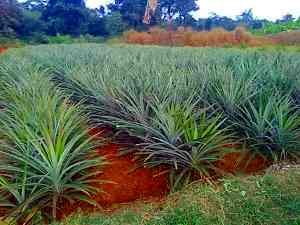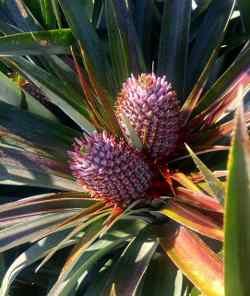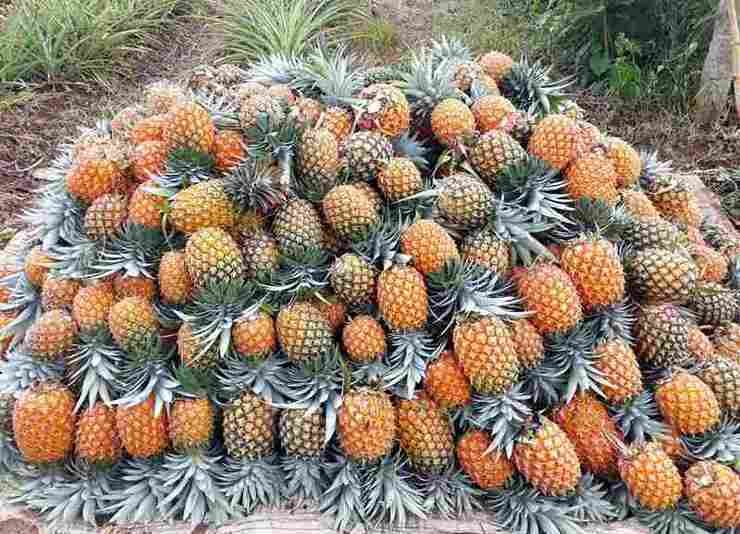Pineapple farming is a profitable business if you know how to grow pineapple especially since it does not suffer too many diseases. Pineapple plantation can be a very good source of income if maintained properly. Discover how to find success in pineapple cultivation.
Pineapples are the one of the most favored fruits and rank next to mango. It is known for its rich, sweet taste and spiny texture. Pineapple is a delicious fruit- spiny and thorny on the outside, sweet and delicious on the inside. The fruit is native to Caribbean, Central America and South America. It is highly nutritious and enjoyed by everyone worldwide.
In India, pineapples grow abundantly in Karnataka, Kerala, West Bengal, North Eastern parts, Bihar, Goa and Karnataka.
Information on Pineapple
Pineapple is botanically called Ananas comosus and is a herbaceous plant growing upto a height of 1.5 meter. The stem is stocky with waxy, thick leaves. Once mature, the plant produces as many as 200 flowers which later coalesce together forming the spiny fruit- pineapple.
Ideal Conditions for Pineapple Farming
Coastal regions are the most ideal places for growing pineapple which needs abundant rainfall and humid climate. It grows at an altitude of 1100m above sea level.

Climate for Pineapple Plantation
As mentioned before, a humid climate with ample rainfall is ideal for pineapple plantation. This type of climate is found in coastal regions. The optimal temperature must be between 22 and 32⁰C. While the leaves grow best at 32⁰C, roots grow best at 29⁰C. Pineapple crops do not grow at temperatures below 20⁰C and above 36⁰C. There must be a difference of 4⁰C between day and night temperatures. However, a high temperature at night is not desirable for pineapples. Though ample rainfall is well-suited for pineapples, it grows best at 100-150 cm rainfall.
Season of Pineapple Farming
Ideally, pineapples are planted 12-15 months before the flowering season. Flowering season occurs between the months of December and March. It varies between regions. Generally, the planting time depends on the onset of monsoon, its intensity, precipitation, etc. It is planted during April- June period in Karnataka and Kerala while in Assam it is done during August to October months. Pineapple cultivation is avoided during the heavy rainy period. Ideal time for cultivation in different states across India is as below:
| Name of the State | Time of Cultivation |
|---|---|
| Assam and other North Eastern States | August to October |
| Kerala and Karnataka | April to June |
| Northern parts of West Bengal | October to November |
| Other parts of West Bengal | June to July |
Soil for Pineapple Cultivation
Pineapples can grow well in any type of soil although sandy loam is the most ideal. The most basic requirement for pineapple farming is the soil must be well-drained. It can even grow in heavy, clay soil provided the soil has good drainage capacity. Soils that log water is not recommended for pineapple cultivation. Alluvial and laterite are other soil types suitable for pineapple plantation.

pH Requirement
Pineapples need slightly acidic soil with a pH between 5.5 and 6.0.
Water for Pineapple Farming
Pineapples are normally cultivated in coastal areas and places where rainfall is abundant. Therefore, irrigation is not really needed. However, if cultivated on a commercial scale supplementary irrigation helps in producing good sized fruits. In addition, irrigation helps in off-season planting. It also ensures all year round pineapple production. This practice is followed for producing export quality pineapples. If grown in areas of scanty rainfall with hot weather, then irrigation must be done once in two weeks.
Planting Material
Pineapples are propagated from crown, slip and suckers. If planted when 5-6 months old, the suckers and slips produce flowers after 12 months. Crowns bear flowers only after 19-20 months. Different varieties are available for commercial cultivation of pineapples. These are produced through tissue culture.
| Name of the Variety | Characteristics | Place of Cultivation | Fruit Yield |
|---|---|---|---|
| Kew |
| Individual fruit weighs 1.5 to 2.5 Kg | |
| Giant Kew |
| Some regions of West Bengal | |
| Charlotte Rothchild |
| Kerala and Goa | |
| Queen |
| Tripura, parts of Assam and Meghalaya | 0.9- 1.3 Kg |
| Mauritius |
| Parts of Kerala | |
| Jaldhup |
| Assam (Jaldhup is the place of production) | |
| Lakhat |
| Assam (Lakhat is place of production) |
Land Preparation for Pineapple Cultivation

Pineapples are cultivated in trenches. Land is ploughed well and made to a fine tilth. Soil clods, rocks, crop debris and stones must be ridden. The land is dug after ploughing and then levelled. Trenches are dug following this. Each trench may be 15-30cm deep and 90cm wide. Generally August to October or April to May is chosen as the ideal time so as to avoid harvest during rainy season.
Pineapple Planting
Unlike other crops, pineapples are propagated from crown, sucker and slip. Therefore, the planting materials used in pineapple cultivation are crowns, slips and suckers. Crowns bear flowers 19-20 months after plantation whereas slips and suckers bear flowers 12 months after plantation. The planting materials to be used for cultivation must be 5-6 months old. Generally, for commercial purposes slips and suckers are used since crowns take longer time to flower. The materials must be uniform-sized. The suckers and slips are planted in previously dug and readied trenches.
Intercultural Operations in Pineapple Plantation
Various intercultural operations like earthing, weeding, mulching, removing slips, suckers and crowns and ratoon crops are practiced in pineapple farming. This is especially because pineapples grow on loose soil with shallow roots. Here are the pineapple farming techniques.
Earthing
Pineapples have shallow roots. Hence they are prone to lodging. If plants lodge during fruit development, it would result in uneven fruit development and a lopsided growth. Earthing helps plants get a good anchorage. In earthing, the soil is pushed down from the ridges into the trench.
Weeding
Weeding is especially important from the economic point for any cultivation. Nutgrass and hariyali are the most common types of weeds in pineapple. Since hand weeding is a laborious process and cumbersome process, chemical weeding is advisable. Combination of diuron with bromacil as a pre-emergency spray is usually recommended. The pre-emergency spray is 0.6 Kg of dirons with 0.8 Kg of bromacil. It repeated with half the concentration after five months of first application.
Mulching
If pineapple is being grown as a rain-fed crop, then this is an essential step. The main aim of mulching is moisture conservation and weed control. Using a black polythene film is the easiest and least laborious way of mulching. However, using a mulch of leaves and straws and spreading them between the pineapple plants in soil is a more organic way of mulching.
Removing Crowns, Slips and Suckers
Suckers and slips grow with the emergence of inflorescence and fruit development respectively. Most suckers and slips are removed while only one or two are retained. Since an increased number of slips delay the maturity of fruits, they are removed as soon as they attain the size required for planting. On the other hand, fruit weight increases with increase in suckers. Therefore, desuckering can be delayed. If the farmer intends an early harvest, then the slips are removed as soon as they appear.
Ratoon Crop
Pineapples can be retained for upto 3 crops in India. In the next cycle of rotation, the suckers used for cultivation are the ones from the original plant. In order to provide a good anchorage for ratoon crop the plants must be adequately earthened and fertilized.
Diseases and Plant Protection in Pineapple Cultivation
Unlike a lot of other crops, pineapples are not dogged by too many diseases in India. In fact, diseases in pineapples are very sporadic. Mealy, scale insects and stem rot are the most likely to occur infection in pineapple cultivation in India. Dipping the suckers in Bordeaux mixture before planting and a good drainage system would take care of stem rot and other fungal diseases.
Abnormalities in Fruits

This is one big challenge of growing pineapples. Pineapples must have the perfect fruit with the perfect oblong shape and the just right ‘pineapple’ flavor. Else they lose market value. Although infections are uncommon in pineapple cultivation, there are different types of fruit abnormalities that pose a threat to pineapple crop commonly. Some of these are as below:
Multiple Crowns
Sometimes, pineapple fruits bear more than one crown (25 crowns in some extreme cases). As a result the top of the fruits grow broad and flat. The fruits are corcky and taste insipid. This is most commonly observed in Kew fruits making it unfit for canning.
Crown and Fruit Fasciation
Fasciation makes pineapples totally useless for consumption. A very high soil fertility and warm weather favors boosts vegetative growth resulting in fasciation. Such plants take a longer time than normal plants to flower. In extreme cases, the fruit may be flat and appear twisted with innumerable crowns.
Collar of Slips
Presence of an innumerable number of slips arising from the stem near the base of the fruit or sometimes from the fruit directly results in this condition. Owing to the excess slip growth, the resultant fruit is tiny, tapered with knobs at the base. Generally, a high nitrogen fertilization, heavy rainfall and relatively low temperature together result in collar of slips.
Harvesting Pineapple

It typically takes 2-2.5 years for pineapples to get ready for harvest. They flower after 12-15 months of planting and start fruiting only after 15-18 months. Usually the fruits ripen after 5 months of inflorescence. Fruits cultivated for canning purposes are harvested as soon as a small change at the base of the fruit is noticed. The ones for table purposes are harvested only after they develop a golden yellow color.
To decide the time of fruit maturity, the level of yellow color at the eyes acts as the indicator. They are decided as below:
- Color Stage (CS) 1: Green eyes with no yellow coloring
- CS2: 5-20% of eyes turn yellow
- CS3: 20-40% eyes turn yellow
- CS4: 40-80% of eyes turn yellow
- CS5: 90% of eyes turn yellow with 5-20% of them reddish brown
- CS6: 20-100% of eyes turn reddish brown
The harvested fruits are graded according to their size, color and weight and then sent for storing. On an average, the yield depends on the cultural practices followed and inter-spacing. However, it varies between 20-30 tonnes per hectare.
Storing Pineapple
After harvest, fruits with crown can be stored upto 15 days without damage. However, those that are transported must be refrigerated during transportation so as to slow down the ripening process. They can be stored at 10-130 C for 20 days. The optimal storage temperature is 7.2⁰C with 80-90% relative humidity.
Conclusion
Pineapple cultivation is a commercially viable farming business as it gives good return with minimal care. A successful pineapple farm requires good farm management and farming techniques.
Reference
- https://en.wikipedia.org/wiki/Pineapple
- http://www.fruitipedia.com/pineapple.htm
- http://agritech.tnau.ac.in/horticulture/horti_fruits_pineapple.html
- http://nhb.gov.in/Horticulture%20Crops/Pineapple/Pineapple1.htm
- http://nhb.gov.in/pdf/fruits/pineapple/pin005.pdf
- http://www.ccari.res.in/dss/pineapple.html#land
- http://www.ccari.res.in/TB.No.35.pdf
- http://vikaspedia.in/agriculture/crop-production/integrated-pest-managment/ipm-for-fruit-crops/ipm-strategies-for-pineapple/pineapple-diseases-and-symptoms
Detailsof pineapple fertilizer pree and post flowering of plants ?
What’s the fertilizers used pree andpost flowering of pineapple plant’s.
Can i be able to use calcium ammonium nitrate as a fertilizer when farming pineapple? Thats when cultivating on heavy clay soil?
how and where i can get the plant( slips or sucker) for plantation. please guide me in details. name of nursery rate and supply method.